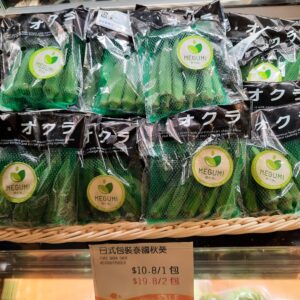香港の日本食材事情 Japanese food in Hong Kong


この間、ある食品メーカーさんの市場調査をさせていただきました。 香港で純和風な料理の作り方を紹介する場合、どのくらい現地で材料が手に入るのかというものでした。純粋な日本料理となると、例えば〇〇を作るのに三つ葉が手に入らないのでできない、というようなこともありますが、もちろんある程度のオルタナティブ*を許容するとすれば、調査対象となった20ほどのレシピのかなりのものがこちらでも再現できそう、食材が入手できそうという結果になりました。 (* オルタナティブというのは、例えば、日本で手に入るものとは性質が違うとしても、きゅうりもナスも手に入るという意味です。)
和食特有の食材を輸入(消費)する側の香港にとっても、輸出する側の日本にとっても、飛行機で約4時間で行き来できるということがアドバンテージになります。例えば、こちらで活躍されていて半年先まで予約の詰まっているお店のお寿司職人さんがおっしゃるには、香港は日本の市場で朝手に入れたものをその日の内に届けられるギリギリの距離ということでした。

日常的なレベルでいえば、香港では「YATA 一田」などの日系食品スーパーマーケット**などで日々の食事用に日本の食材を手頃な値段で手に入れることが満足にできます。そう考えてみると、わずか15年ほど前まで、日本米が手に入らないから日本への一時帰国時に重たいお米を持って帰って来られた人が多かったという頃とは隔世の感がありますね。例をあげると、お米、卵、納豆などは普通にあります。そして、お値段は安くないにしても果物、乾物、調味料、加工食品などはかなり選択肢が増えました。
思えば20年も昔、上海にいた時代、かなり割り増しでしたがハウスのジャワカレーを売っているのを見つけて、何をさておいても購入しました。また、家の近くの市場ですこし色が暗くなったお肉を買って、外国人向けの割高なデリでじゃがいもや玉ねぎ、人参を手に入れて毎週のようにカレーライスを作って食べるのが贅沢でした。カレーライスを上海の友人にも食べさせたいと、当時彼らが住んでいた租界時代の住宅の共同台所で具を切ったり、ごとごと煮込んだり、中華鍋を洗ったのを思い出します。
消費者目線では日本の食材が手頃に入手できるようになってほしい一方で、ビジネスとしては日本の生産者さんたちが市場を広げるだけでなく高級の日本食材を展開してほしいとも思います。
**註:このスーパーはローカルのものですが、もともとは西武系で日本のものを積極的に売っています。ウェルカムやパークンショップといった大手スーパーチェーンにはそれほど日本食材は見られません。ただジャワカレーは売っていたり、お米、卵、納豆、お肉の類はあり、やはり全体として日本食材が広がりを見せていることは間違いありません。

Recently, we conducted a market research for a food company. The purpose of the survey was to find out how much Japanese food ingredients are available in Hong Kong when introducing recipes for Japanese dishes. If we accept a degree of alternatives*, it turns out that quite a few of the 20 of recipes could be easily prepared in Hong Kong. (*Alternatives mean, for example, that cucumbers and eggplants are available, even if they are different from those in the original recipe.
For both Hong Kong as an importer (consumer) and Japan as an exporter of ingredients of Japanese dishes, the fact that it takes only about four hours to fly to and from Hong Kong is an advantage. A sushi chef here, who has a restaurant which is so popular that it is booked up to six months in advance, told me that Hong Kong is just far enough away that they can deliver what they get in the morning at the Japanese market on the same day.
On a daily life level, in Hong Kong, you can satisfactorily get Japanese food for daily meals at affordable prices at Japanese food supermarkets** such as “YATA”. Looking back, it seems like a far different life from just 15 years ago, when people used to bring rice back to Hong Kong when they temporarily returned to Japan because they could not get Japanese rice. For example, rice, eggs, and natto are commonly available. And even though the prices may not be cheap, there are more choices for fruits, dried foods, seasonings, and processed foods.
20 years ago, when I was in Shanghai, I found Japanese curry sold at a expensive price, and I bought it without any hesitation. I also bought some meat that was a little darker in the market, and potatoes, onions, and carrots from an expensive deli for foreigners, and made curry and rice every week. I remember chopping the ingredients, stewing, and washing the wok in the common kitchen of the residential complex in the concession area where they lived, in order to feed curry and rice to my friends in Shanghai.
From a consumer’s point of view, I would like to see Japanese food products become more affordable in Hong Kong, while from a business viewpoint, I would like to see Japanese producers not only expand their market but also expand their high-end Japanese food products.
**Note: This supermarket is a local one, but it is originally a Seibu chain and actively sells Japanese products. Major supermarket chains such as Wellcome and PARKn Shop don’t sell as many Japanese products. However, they do sell Javanese curry, rice, eggs, natto, and meat, so there is no doubt that Japanese food is expanding as a whole.

